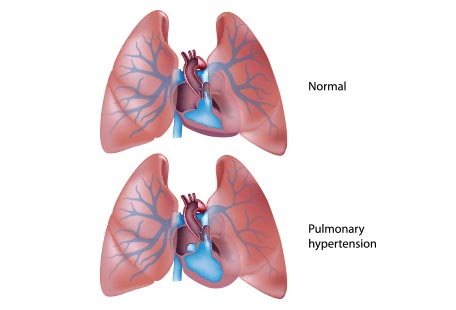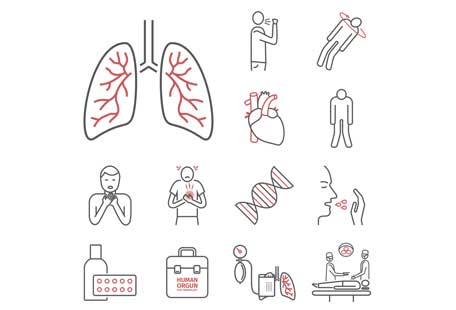ارتفاع ضغط الدم الرئوي

 حول ارتفاع ضغط الدم الرئوي
حول ارتفاع ضغط الدم الرئوي
هو مرض مُتزايد يقلل من تدفق الدم ويزيد الضغط في شرايين الرئتين.
 شرايين الرئتين هي الشرايين الكبيرة المسؤولة عن نقل الدم من القلب إلى الرئتين للتشبع بالأكسيجين.
شرايين الرئتين هي الشرايين الكبيرة المسؤولة عن نقل الدم من القلب إلى الرئتين للتشبع بالأكسيجين. في ارتفاع ضغط الشريان الرئوي تتضخم الخلايا المبطنة للداخل من هذه الشرايين وتتضاعف .
في ارتفاع ضغط الشريان الرئوي تتضخم الخلايا المبطنة للداخل من هذه الشرايين وتتضاعف . ونتيجة لذلك قد تضيق جدران الشرايين وتتضخم.
ونتيجة لذلك قد تضيق جدران الشرايين وتتضخم. تتسبب في منع تدفق الدم من خلالها وبالتالي يزيد ضغط الدم.
تتسبب في منع تدفق الدم من خلالها وبالتالي يزيد ضغط الدم.
 أعراض ارتفاع ضغط الدم الرئوي
أعراض ارتفاع ضغط الدم الرئوي
يعاني الأشخاص المصابون بارتفاع ضغط الدم الرئوي من مجموعة من الأعراض التي تختلف في شدتها اعتمادًا على طبيعة حالتهم.
الأعراض الأكثر شيوعًا
 الإجهاد عند ممارسة المجهود
الإجهاد عند ممارسة المجهود إغماء
إغماء الشعور بالدوار خاصة عند صعود السلالم
الشعور بالدوار خاصة عند صعود السلالم التعب الشديد
التعب الشديد ضيق التنفس
ضيق التنفس البدني
البدني ألم في الصدر خاصة أثناء النشاط البدني
ألم في الصدر خاصة أثناء النشاط البدني خفقان
خفقان تورم الساقين والكاحلين
تورم الساقين والكاحلين سعال.
سعال. عند فشل الجانب الأيمن من القلب
عند فشل الجانب الأيمن من القلب
- يتفاقم ضيق التنفس
- يتزايد التعب
- يحدث استسقاء بالكاحل
- يحدث الخفقان في الرقبة
- يظهر شعور الامتلاء في البطن
- الشفاه والأظافر قد يصبح لونهما أزرقًا.


 أسباب ارتفاع ضغط الدم الرئوي
أسباب ارتفاع ضغط الدم الرئوي
 مرض النسيج الضام (مثل تصلب الجلد أو الذئبة أو التهاب المفاصل الروماتويدي)
مرض النسيج الضام (مثل تصلب الجلد أو الذئبة أو التهاب المفاصل الروماتويدي) تليف الكبد
تليف الكبد عدوى فيروس نقص المناعة البشرية
عدوى فيروس نقص المناعة البشرية الميثامفيتامين والكوكايين
الميثامفيتامين والكوكايين عيوب القلب الخلقية
عيوب القلب الخلقية نادرًا، مرض وراثي.
نادرًا، مرض وراثي.
 تشخيص وعلاج ارتفاع ضغط الدم الرئوي
تشخيص وعلاج ارتفاع ضغط الدم الرئوي
 إن ارتفاع ضغط الدم الرئوي لايُشخص بسهولة عادةً، لأن الأعراض المبكرة يمكن ان تتشابه مع أعراض لأمراض أخرى للقلب والجهاز التنفسي. يمكن أن تكون الأعراض في البداية خفية وغير محددة نسبيًا.
إن ارتفاع ضغط الدم الرئوي لايُشخص بسهولة عادةً، لأن الأعراض المبكرة يمكن ان تتشابه مع أعراض لأمراض أخرى للقلب والجهاز التنفسي. يمكن أن تكون الأعراض في البداية خفية وغير محددة نسبيًا.  التشخيص
التشخيص
إذا اشتبه طبيبك في احتمال إصابتك بـارتفاع ضغط الشريان الرئوي، فسوف يطلب إجراء اختبارات لمعرفة ما إذا كان هناك إجهاد على الجانب الأيمن من قلبك.
- مخطط كهربائية القلب
- الأشعة السينية على الصدر
- اختبارات وظائف الرئة
- تخطيط صدى القلب (الموجات فوق الصوتية لقلبك)
- فحص الرئة بالتهوية
- فحص البطن بالموجات فوق الصوتية
 علاج او معاملة
علاج او معاملة
مضادات التجلط الفموية (حبوب منع تخثر الدم)
- مدرات البول
- العلاج بالأكسجين
حاصرات قنوات الكالسيوم (حبوب): فقط للمرضى الذين يستجيبون للاختبار التفاعلي الحاد الذي يتم إجراؤه.
- بروستاسيكلين مركب وبروستاسيكلين مشابه
- ناهضات مستقبلات الإندوثيلين (حبوب)
- مثبطات الانزيم فوسفودايستريز رقم 5 (حبوب)
 DO’s and DON’Ts
DO’s and DON’Ts
 Asthma can’t be cured, but its symptoms can be controlled. Because asthma often changes over time, it’s important that you work with your doctor to track your signs and symptoms and adjust treatment as needed.
Asthma can’t be cured, but its symptoms can be controlled. Because asthma often changes over time, it’s important that you work with your doctor to track your signs and symptoms and adjust treatment as needed.
The key to living with asthma successfully is to keep it under control. Limit contact with asthma triggers in your environment, monitor your condition with a peak flow meter, and follow your treatment plan strictly.
Work on reducing asthma triggers. A first step is to stop smoking and protect yourself second-hand smoke in your home and in public places.
It is possible to be active and stay healthy when you’re living with asthma. In fact, many medal-winning Olympic athletes have asthma. Exercise strengthens your respiratory muscles, helps maintain weight.Exercises that are less likely to trigger asthma symptoms include swimming, walking, hiking, and leisurely biking. Sports that have short bursts of activity are also less likely to set off symptoms. Examples include baseball, football, and sprinting.
You may have to pace yourself at times or make some adjustments here or there, such as avoiding outdoor sports in the early morning, when pollen counts are at their highest (assuming pollen is one of your triggers).
Stress can be a trigger for asthma attacks. With that in mind, commit to implementing stress-reduction strategies into your life, such as breathing exercises, meditation, and other tactics.
Stay mindful of your emotional state. People with asthma may be more likely to develop anxiety or depression. If you begin to feel down or depressed, talk with your doctor. Help is available.
Asthma presents a number of day-to-day challenges that need to be overcome. Take steps to make it easier for you to commit to these
Simply checking and recording peak flows once per day could make a big difference in your asthma control. A low number can indicate you may be headed toward an asthma attack.
Learn how to use your medications correctly. Find out all you can about your asthma medicine, including how and when to take it, potential side effects, and how it controls your asthma. If you use a metered dose inhaler, learn how to use it properly.
Talk to your doctor about adjusting your routine if compliance is becoming an issue or you are experiencing side effects.
Not having your rescue inhaler immediately available can be dangerous. Because you have no idea when you might need it, consider keeping a spare in your backpack, purse, desk, or any place Even people who take their asthma medicine exactly as prescribed and who work to avoid triggers can have the occasional asthma attack. It's essential to have an asthma action plan in place for those times. This will include symptoms to look for, actions to take, danger signs, avoiding triggers, medication instructions, and when to call your doctor or go to the emergency room.
معلومات مفيدة
قريبًا
تواصل مع أحد أطبائنا









